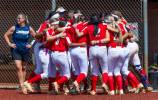Celebration of Labor: A day to laud work ethic of Americans
This holiday weekend, as the cooler weather of autumn flickers from the horizon, let’s not be alarmists: Even if there are more hamburgers and fewer T-bones on those backyard grills for yet another year, neither famine nor pestilence stalks the land.
Visitor volume is up, sales tax revenues are up, and there are plenty of signs that Nevadans’ patience, hard work and sacrifice will yet pay off.
Yes, it’s a Labor Day weekend when nearly 10 percent of Nevada workers want a job, and 19 percent presumably wish they had the kind of full-time job with pay and benefits that were considered standard a mere six years ago.
The U.S. Bureau of Labor Statistics actually compiles six simultaneous unemployment rates, from the U-1 (persons unemployed 15 weeks or longer) to the U-3 (total unemployed as a percent of the civilian labor force — the definition used for the official unemployment rate) to the U-6 (total unemployed, plus total employed part-time for economic reasons, plus those who’ve given up looking for work). And as you might expect, for the four quarters ending in June 2013, Nevada again reported the highest rates in the country for all six measures of unemployment. Nevada’s rates ranged from a U-2 of 5.9 percent to a U-6 of 19.0 percent, with the official U-3 rate at 10.4 percent.
The next highest U-3 rates? Heavily regulated California and Rhode Island, at 9.5 percent each.
Nor did underwater Nevada homeowners need the Census Bureau to tell them that Americans’ median household net worth declined 35 percent between 2005 and 2010, from $102,844 to $66,740 in constant dollars. (Median household net worth actually would have increased a bit, from $13,859 to $15,000, if it weren’t for mortgage debt. Karen Dynan, senior fellow at the Brookings Institution, told ABC News the figures show the devastating effect of the housing bust on the condition of American families.)
But Americans have always been a people who see the glass half-full, who would rather concentrate on the possibilities of the future.
That may be why America’s Labor Day differs from Europe’s.
“Disruption was to be part of the holiday” first announced in 1889 by the first Paris Congress of the Second Socialist International, reports Julia Vitullo-Martin, editor of “Breaking Away: The Future of Cities.”
“And there was no notion that anyone but workers would participate — certainly not owners or capitalists.”
No one should suggest the American struggle to gain recognition for the right of workers to organize was a mere walk in the park. Compared with Europe, however, things in America proceeded in a generally more conciliatory vein.
Matthew Maguire, a machinist from Paterson, N.J., and Peter J. McGuire, a New York City carpenter, were instrumental in staging the first Labor Day parade in New York City in September 1882. No heads were broken. And by 1894, President Grover Cleveland had signed a bill making Labor Day a national holiday.
It may be this notion — that a celebration of labor and the fruits of our labors is an appropriate undertaking for Americans of all classes and political persuasions — that allowed America’s holiday to be marked with “picnics, parades, baseball games … and a few mild speeches,” rather than “clashes between cops and workers,” Ms. Vitullo-Martin theorizes.
Europe’s socialist labor movement assumed a Manichaean duality: Workers were good, employers evil.
In America, on the other hand, union pioneer George Meany advised his brethren to avoid divisive, partisan politics. The average American worker realized early on that his energy and creativity could increase the value of his employer’s product, often making the difference between whether a company succeeded or failed.
Thus the inevitable decline of the old-style, confrontational union in the private arena. The collapse of bureaucratized socialism around the world stands in stark contrast to the material health and well-being of the lowliest worker in a free, capitalist society, even in a bad year — a well-being undreamed of by even the elite of previous generations.
That’s why we Americans can be proud of our work, setting aside a weekend each year not just for a last summer fling, but also to honor what we and our forebears have built — and the labor it took to get it done.
A version of this editorial originally appeared last year.


















